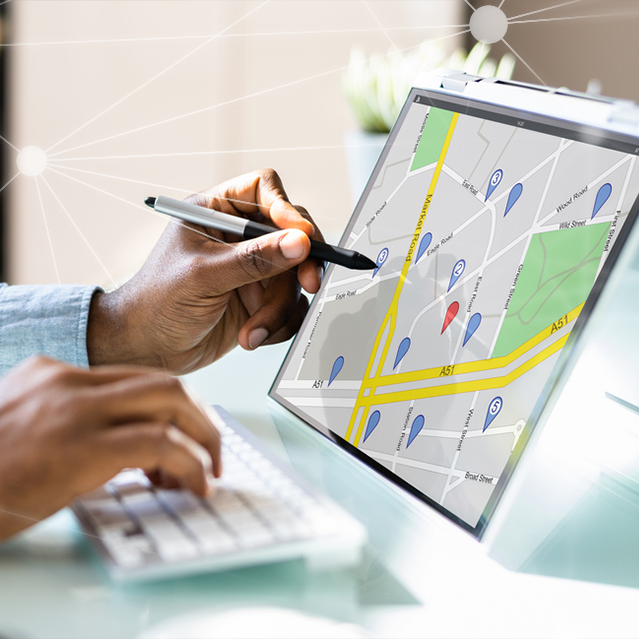Geotracking Puts Your Privacy at Risk. Here’s How You Can Protect Yourself
Summary: Using your phone or other digital devices can reveal your physical location via a practice called geotracking. It can be a serious privacy-protection issue. Not only can your location and similar data be sold to advertisers and other third parties through data brokers, it can wind up for sale on the dark web. Take steps to minimize the risks to your geodata.

Your physical location is a data point that can be sold to advertisers, or exploited by scammers and stalkers
Did you know that apps, websites, and devices have “eyes” on the exact spot you’re occupying right now? And that your specific physical location and history, known as geodata, are part of a personal data profile that’s not only being sold to advertisers, but are potentially being exposed to scammers and other malicious actors?
It’s a practice called geotracking, in which third parties trace your precise location using your device’s IP address, your Wi-Fi or cellular signal, and more. Depending on the level of privacy protection you’ve got in place, it’s likely happening in the background whenever you visit various websites, use popular apps, or simply have your device open. Make sure you’re protecting yourself against this potential risk to your privacy and identity.
How geotracking can be helpful
To be clear, geotracking is in some ways useful to our daily lives. For example, it enables certain apps to deliver necessary services, such as ride-share apps using your location to help their drivers find you. Similarly, your device’s operating system can employ location tracking to deliver its own important services—think of the “Find My Phone” feature—or improve your experience when using the device manufacturer’s products.
How geotracking is used for unwanted purposes
The privacy risks with geotracking, however, are real. Many websites and apps record your location and other personal data to create a profile of you, which can then be sold to advertisers and other third parties via so-called data brokers or “people search” sites. The stated purpose of this data-gathering is to bring you targeted advertising—it’s why, for example, you might see online ads for banks or restaurants in your neighborhood.
You may or may not find this type of pinpoint targeting to be intrusive. The bigger privacy issue is that some untrustworthy apps may be utilizing geotracking for nefarious means, like spying on your activities and movements. Scammers and stalkers may be using geotracking to determine your precise location for the purpose of stealing your identity, or worse.
Different groups face varying kinds of geotracking risks. For instance, people who use the same devices to connect to both their home and work networks must manage the privacy risks to both themselves and their employer. Children, meanwhile, face risks when they or their parents post geo-tagged videos or images of the child on social media, potentially allowing the child’s activities to be tracked, or revealing the child’s location to those who wish them harm.
How to limit the amount of geodata that’s collected on you
The good news is that you can take practical steps to improve your privacy protection and limit the amount of personal geodata being recorded and sold. A few quick tips:
- On your phone, go to your privacy settings and deactivate location services for any app that doesn’t absolutely need it.
- If you do allow an app to track your location, change the settings if possible so that the tracking can only occur when you have the app open.
- To avoid spyware and other forms of malware, download apps only from trustworthy sources.
- For social media, choose the strictest privacy settings that you feel comfortable with. Also, before you take pictures or videos that you plan to post to social media, turn off any geo-tag settings on your phone.
How to get comprehensive data protection
The best way to minimize the risks of geotracking and other data-tracking practices is to consider a comprehensive privacy and identity protection plan like the ones offered by IDX. These plans are designed to help safeguard all data points within your personal profile, including your geodata. Here are just a few examples of the types of protection you’ll receive:
Safe Web Browsing
Do you use public Wi-Fi? Know that scammers and stalkers can potentially take advantage of the open network to access your information, online behavior, or geolocation. IDX’s SafeWiFi is a Virtual Private Network (VPN) that allows you to keep your information private when using public Wi-Fi—moving your data through a hidden, encrypted connection.
Personal Data Removal
If your personal data profile winds up for sale on data broker sites, you can use IDX’s ForgetMe Personal Data Removal tool to get your profile removed automatically. Deleting your profile manually is difficult and time-consuming; ForgetMe does all the work for you, and keeps automatically requesting removal as often as necessary until the site stops reposting it.
Dark Web Monitoring
Should your personal information become part of a data breach, you’d want to know right away if it’s being sold by cybercriminals on the dark web. IDX’s CyberScan tool continuously monitors all layers of the web, including the dark web, and alerts you if it finds that your information has been compromised. You’ll gain valuable time to help avoid becoming a victim of identity fraud.
It’s a bit unsettling to think about all the ways your movements can be tracked when you use your phone or other digital devices. Be sure to check your privacy settings to see who’s tracking you and under what circumstances. Better yet, consider a thorough privacy and identity protection plan to reduce the risks across your entire data profile.
About IDX
We're your proven partner in digital privacy protection with our evolving suite of privacy and identity products.




